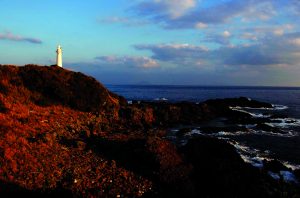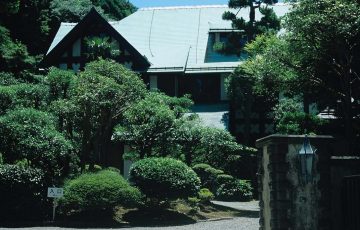With the Black Ships Festival just around the corner, Rob Gilhooly drops in on the historical port town of Shimoda.
“Ah! The moon is up, and tomorrow we’ll be in Shimoda,” said the little dancer. “I love Shimoda.”

There’s much to love about today’s Shimoda, though not necessarily what Kaoru, the little dancer and central character in Yasunari Kawabata’s celebrated novella The Izu Dancer, found endearing about the town of the 1920s.
She loved its diversions, its movie houses and the camaraderie of the itinerant performers who converged on the town to entertain and be entertained. “Shimoda,” observed Mizuhara, the young narrator of Kawabata’s semi-autobiographical story, was something of a “nest for migrants.”
More than 80 years on, itinerant performers in the southern Izu town are about as numerous as its movie theaters – the last of which closed its doors around 30 years ago. Come summer, however, the place is more than just a nest for migrants, and visitors descend on the town and its environs in droves.
 Shimoda is located just 160 kilometers southwest of Tokyo near the southernmost tip of the Izu Peninsula, a region boasting fine, white sand beaches and waters that regularly feature in annual governmental surveys for being among Japan’s cleanest.
Shimoda is located just 160 kilometers southwest of Tokyo near the southernmost tip of the Izu Peninsula, a region boasting fine, white sand beaches and waters that regularly feature in annual governmental surveys for being among Japan’s cleanest.
Its proximity to the nation’s capital makes it a popular getaway for work-weary Tokyoites, and on a summer weekend rooms in the area’s abundant guest houses and hotels are as plentiful as seats on a rush-hour Yamanote Line train.
The climate is mild year-round, largely thanks to the Kuroshio (black stream) current that runs northward from Taiwan, transporting warm tropical waters and supporting the globe’s northernmost corals that fringe Izu’s coastline.
Meanwhile, subterranean activity helps maintain a healthy flow of even hotter water; Izu, particularly the once regal towns of Atami and Ito on the east coast and Shuzneji at its center, has long been synonymous with the ubiquitous Japanese onsen.
Yet, this is far more than just a beach and bath retreat, and history buffs will find as much to satisfy them as beach bums. Indeed, international attention already had been focused on this part of Shizuoka prefecture well before Nobel laureate Kawabata had even been born.
It was into Shimoda’s fine natural harbour that US Commodore Mathew Calbraith Perry’s fleet of “black ships” arrived in 1854, ending Japan’s 215-year self-imposed isolation from the rest of the world. Perry demanded that two ports be opened to foreign vessels and the Japanese government offered Shimoda as one, considering it to be isolated enough to keep the foreign barbarians at arm’s length.
Though well served by train from Tokyo, the town maintains that slightly remote feel, possessing an understated, convivial charm with tree-lined streets and fine old buildings, some featuring traditional namako-kabe – walls made from charcoal grey tiles sealed with thick, rounded strips of white plaster, thought to resemble sea slugs (namako in Japanese).
Other historical sites abound. There’s Ryosen-ji Temple, where Perry penned the US-Japan Kanagawa Treaty in March 1854; Gyokusen-ji Temple, where two years later the first US consulate was inaugurated by Townsend Harris, and a museum devoted to Harris’ reluctant lover Okichi, who committed suicide some years after Harris’ return to the US having been ostracized by the local community.
Unsurprisingly, the town cashes in on its link with Perry and his kurofune, or, black ships.
 There is Perry Road – a leafy lane of cafes and antique stores so named after a disputed claim that the commodore once strolled along it; a bust of Perry, situated near the seaside entrance to the lovely Shimoda Park and particularly popular with the town’s birdlife; the Sasukehana cruise ship, modeled on one of Perry’s fleet, which tours regularly along the harbor; and the annual Kurofune Festival, featuring a parade of well-groomed American dignitaries chauffeured in open-top limos and pursued by marching local residents decked out in period costume – some dressed as Perry himself.
There is Perry Road – a leafy lane of cafes and antique stores so named after a disputed claim that the commodore once strolled along it; a bust of Perry, situated near the seaside entrance to the lovely Shimoda Park and particularly popular with the town’s birdlife; the Sasukehana cruise ship, modeled on one of Perry’s fleet, which tours regularly along the harbor; and the annual Kurofune Festival, featuring a parade of well-groomed American dignitaries chauffeured in open-top limos and pursued by marching local residents decked out in period costume – some dressed as Perry himself.
Then there are eateries serving Perry steak, Kurofune cake, Kurofune ramen… even the town’s man-hole covers are adorned with Kurofune designs.
Beyond the town, however, the sea beckons, and some fine beaches are within easy reach. Shirahama Beach is most popular with surfers, while Kisami-Ohama Beach and neighboring Goishihama Beach are favored by the expat community – many foreign businesses and dignitaries have their summer holiday homes in the vicinity.
But, for those looking for a little seclusion, Kujippama beach is hard to beat. About 15 minutes by car or bus from the town center, this once virtually unknown little cove is a good 10-minute walk from the nearest road down a steep, narrow path that snakes through shady woodland. The water here is crystal clear and perfect for snorkeling, though venturing too far may cause a royal raucous – just a stone’s throw away is the private beach of an imperial family summer retreat.
For a break from sun and sand, a short scramble around a rocky promontory brings you to Cape Tsumekizaki, where a maze of walking tracks crisscross a grassy outcrop that comes alive with color in late December when three million wild narcissus flowers are in bloom. To the east of the cape’s stately lighthouse lies two pristine, sandy bays, and to the west a cliff of rust-red hexagonal columns not unlike Giant’s Causeway in Northern Ireland, though somewhat smaller in scale.
Beyond Shimoda, to the south and west of the peninsula, Izu becomes increasing rugged and less populated, with some stunning views, particularly north of Matsuzaki, where on a clear day Mt Fuji can be seen rising majestically above the glistening waters of Suruga Bay. There are few beaches of any note on the east side, but the scenery is to die for.
What’s not to “love” about this part of Japan?
Access from Tokyo
There are various “odoriko” express trains departing Tokyo (and occasionally Shinjuku and Ikebukuro): The Odoriko Superview runs hourly and is the fastest (approx. 2 hrs 40 mins) and, at ¥6,460 one-way the most expensive option, while other Odoriko express trains (¥6,090 one-way) take slightly longer. Local trains via a combination of the Tokaido and Ito Lines are the least expensive (¥3,780 one-way) and therefore most time consuming (around 3 hrs 45 mins), involving at least one change at Atami and/or Ito and/or possibly Izu Kogen. Another option is to take the Shinkansen to Atami, then local train or Odoriko from there (around ¥5,900, approx 3 hrs).
Getting Around
The east coast is well serviced by train (Ito Line/Tokaido lines), but for elsewhere on the south or east coasts of the peninsula buses depart from Shimoda Station.
Onsen
In Shimoda, many hotels and guesthouses have in-house baths. One of note is Garden Villa (tel: 0558-22-8080; web: www.gardenvilla.jp) – a beautifully situated and well-run guesthouse with friendly staff. Located between Iritahama and Shirahama beaches, it sports a lovely outdoor bath overlooking the ocean. On the west coast, many guesthouses at Heda, north of Matsuzaki, offer baths with fine views over Suruga Bay. Inland, about 40 minutes by bus on the overland route to Matsuzaki, Osawa Onsen is a quiet hot spring town with just a few accommodations. These include the Osawa-so – not so up-market as its more illustrious neighbor, the Osawa Onsen Hotel (tel: 0558-43-0121), but with a remarkable rotenburo, or outdoor bath.
Story by Rob Gilhooly
From J SELECT Magazine, May 2006















Recent Comments